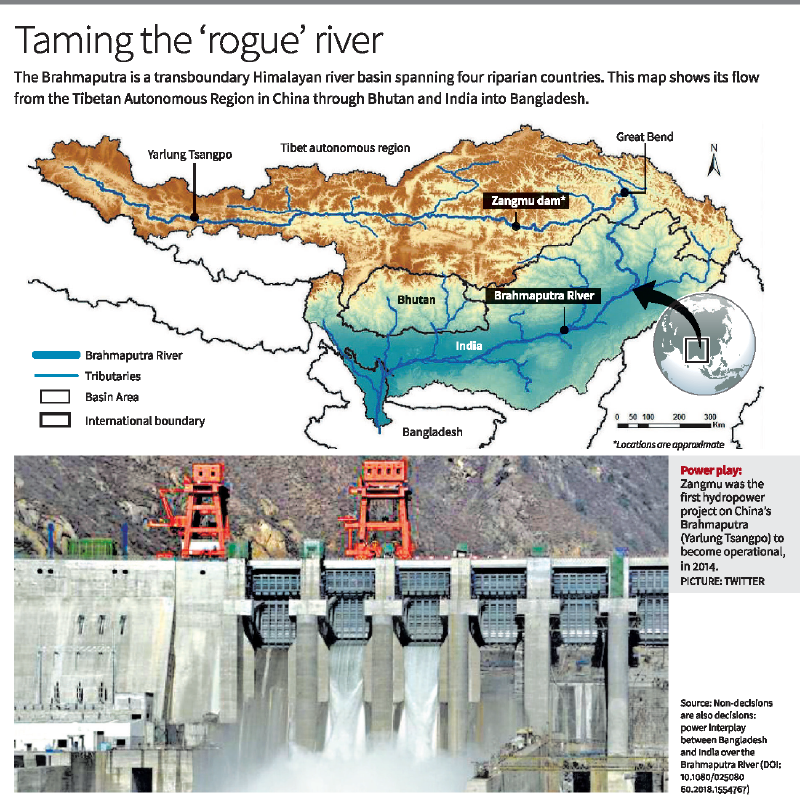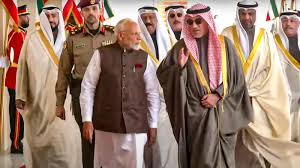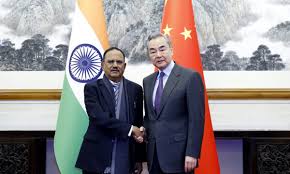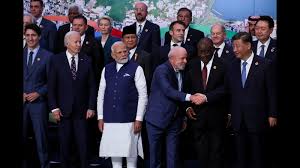Implications of China’s Mega-Dam Project on the Brahmaputra River Basin

- 07 Jan 2025
Introduction:
China has approved the construction of the Yarlung Tsangpo hydropower project, the world's largest hydropower project, with a capacity of 60,000 MW, on the Brahmaputra River in Tibet. This mega-dam, located at the Great Bend in Medog county, has significant geopolitical, environmental, and socio-economic implications for India, Bhutan, and Bangladesh, the downstream riparian countries.
Geographical and Geopolitical Context:
- The Brahmaputra is a transboundary river system flowing through China, India, Bhutan, and Bangladesh.
- China, located at the river’s source in Tibet, is the uppermost riparian nation, controlling water flow into India and Bangladesh.
- All riparian countries, including China, India, Bhutan, and Bangladesh, have proposed major water infrastructure projects in the river basin, which has become a site for geopolitical rivalry, with mega-dams symbolizing sovereignty.
China’s Hydropower Ambitions:
- The Yarlung Tsangpo project is part of China’s 14th Five-Year Plan (2021-2025) and aims to address the country's energy needs while moving towards net carbon neutrality by 2060.
- The river's steep descent from Tibet provides an ideal location for hydroelectricity generation.
- China’s previous mega-projects, like the Three Gorges Dam, highlight the scale of these ambitions but also raise concerns about environmental and social consequences, including ecosystem disruption, displacement, and seismic risks.
Impact on Downstream Communities:
- Water Flow and Agriculture: China’s mega-dam may significantly alter water flow to India, particularly affecting agriculture and water availability in the northeastern regions. India, reliant on the Brahmaputra for irrigation and drinking water, could face disruptions.
- Silt and Biodiversity: The blocking of silt essential for agriculture could degrade soil quality and damage biodiversity in the river basin.
- Seismic Risks: The region’s seismic activity, coupled with the construction of large dams, heightens the risk of catastrophic events such as landslides and Glacial Lake Outburst Floods (GLOFs), which have previously caused devastation in the Himalayas.
Hydropower Competition Between China and India:
- Both China and India are competing to harness the Brahmaputra's potential for hydropower, with India planning its own large project at Upper Siang.
- Bhutan has also proposed several medium-sized dams, raising concerns in downstream countries about cumulative impacts.
- No comprehensive bilateral treaty exists between India and China to regulate shared transboundary rivers, though they have mechanisms for data sharing and discussions on river issues.
Environmental and Regional Concerns:
- The Brahmaputra river basin is an ecologically sensitive region. The construction of large dams threatens the fragile ecosystem, including agro-pastoral communities, biodiversity, and wetlands.
- Tibet’s river systems are vital for the global cryosphere, affecting climate systems, including monsoon patterns. Disruption to these systems could have broader implications for regional and global climate stability.
Challenges in Bilateral Cooperation:
- India and China have struggled with effective coordination on river management. China has shown reluctance to share critical hydrological data, a concern amplified by the lack of a binding agreement.
- The ongoing geopolitical tensions between the two countries, particularly over the border dispute, further complicate cooperation on transboundary water issues.
Recommendations for India:
- Enhanced Cooperation: India should push for renewed agreements and mechanisms for real-time data exchange with China to prevent ecological and socio-economic damage.
- Public Challenges: India needs to challenge China’s claims that its hydropower projects will have minimal downstream impact, ensuring that India's concerns are addressed in international forums.
- Diplomatic Engagement: Water issues should be prioritized in India’s diplomatic engagement with China, emphasizing the importance of transparency and cooperation to ensure mutual benefit and regional stability.
Conclusion:
The Yarlung Tsangpo mega-dam project poses significant risks to the entire Brahmaputra river basin. A collaborative approach, involving transparent dialogue and cooperation among riparian countries, is essential to mitigate the potential adverse impacts on downstream communities and the fragile Himalayan ecosystem.
India-Kuwait Ties

- 24 Dec 2024
In News:
Prime Minister Narendra Modi's two-day visit to Kuwait marks a significant milestone in India-Kuwait relations, being the first visit by an Indian Prime Minister in over four decades. This visit, undertaken at the invitation of Emir Sheikh Meshal Al-Ahmad Al-Jaber Al-Sabah, aims to strengthen bilateral ties in key areas like trade, defense, energy, and cultural cooperation.
Strategic Partnership and Key Agreements
The visit elevated India-Kuwait relations to a 'Strategic Partnership,' with agreements covering diverse sectors. A Memorandum of Understanding (MoU) on defense cooperation was signed, focusing on joint military exercises, coastal defense, and training. Furthermore, the two countries signed a Cultural Exchange Programme for 2025-2029 and an Executive Programme on Sports Cooperation for 2025-2028, enhancing cultural and people-to-people ties.
The establishment of a Joint Commission on Cooperation (JCC) will monitor bilateral relations, and new Joint Working Groups (JWGs) have been set up in areas like education, trade, and counter-terrorism. Both nations also agreed to deepen collaboration in emerging sectors such as semiconductors, artificial intelligence, e-governance, and technology sharing.
Economic and Energy Cooperation
India and Kuwait share strong economic ties, with bilateral trade reaching USD 10.47 billion in 2023-24. Kuwait is India’s sixth-largest crude oil supplier, meeting 3% of India's energy needs. The countries have also agreed to transition from a buyer-seller relationship in energy to a more comprehensive partnership, with focus areas including oil, gas, refining, and renewable energy. Kuwait’s membership in the International Solar Alliance (ISA) was welcomed by India, reflecting their growing collaboration in the energy sector.
Indian Diaspora and Labour Cooperation
The Indian community, numbering over 1 million, forms the largest expatriate group in Kuwait and plays a pivotal role in the country’s economy. Their contribution spans various sectors, including healthcare, engineering, retail, and business. Kuwait’s Vision 2035, which seeks to diversify its economy beyond oil, presents significant opportunities for collaboration with India, particularly in infrastructure, renewable energy, and technology.
The skilled workforce from India also aligns with Kuwait's developmental goals, offering further opportunities for labor cooperation, especially in sectors like healthcare, technology, and infrastructure.
Geopolitical and Multilateral Cooperation
India-Kuwait relations hold regional significance, particularly in West Asia. Kuwait's role in the Gulf Cooperation Council (GCC) amplifies its geopolitical importance. India’s engagement with Kuwait helps maintain a balanced presence in the region, essential for its energy security and broader geopolitical interests. The GCC, which includes six Arab states, remains a key partner for India, contributing to significant trade and remittances. India also seeks to conclude a Free Trade Agreement with the GCC to enhance economic collaboration.
Cultural and Historical Ties
India and Kuwait’s relationship has deep historical roots, dating back to the pre-oil era when maritime trade was a cornerstone of Kuwait’s economy. Over the years, this relationship has grown, with India being a major trading partner and Kuwait contributing significantly to India's energy needs. The Indian Rupee was once the legal tender in Kuwait, underscoring the strength of their historical ties.
In conclusion, PM Modi's visit to Kuwait sets the stage for enhanced cooperation across several domains, reinforcing the strategic partnership between the two nations. It also highlights India's broader objectives in the West Asia region, balancing economic, geopolitical, and cultural interests.
Revitalization of India-China Relations: A Diplomatic Turning Point

- 23 Dec 2024
In News:
The 23rd meeting between India’s National Security Adviser (NSA) and China’s Foreign Minister, held as Special Representatives (SRs), marks a pivotal moment in the complex bilateral relationship between the two nations. This dialogue, which follows years of strain exacerbated by the 2020 Galwan Valley clash, signals a renewed commitment to restoring stability and fostering peace along the border.
Special Representatives Mechanism: A Foundation for Dialogue
The SR mechanism, established in the early 2000s, has long served as a key platform for addressing bilateral disputes, particularly the contentious boundary issue. Past rounds of discussions have facilitated troop disengagement and efforts to maintain peace along the Line of Actual Control (LAC). The recent meeting, following the 2023 BRICS summit discussions between Prime Minister Narendra Modi and Chinese President Xi Jinping, demonstrates a positive step towards de-escalation, with the resumption of talks providing hope for progress.
Key Outcomes of the 23rd SR Meeting
Several significant developments emerged from the meeting, focusing on cultural, economic, and strategic cooperation:
- Cultural and Economic Cooperation:
- Kailash-Mansarovar Yatra: The resumption of this religious pilgrimage represents a significant cultural exchange, fostering people-to-people ties.
- Border Trade Revival: Border trade in Sikkim has been reestablished, potentially revitalizing local economies and improving trade relations.
- Scientific and Environmental Cooperation:
- Trans-boundary River Data Sharing: China’s commitment to sharing crucial river data with India will aid in flood management, directly addressing India’s long-standing concerns over water security, particularly in light of China's upstream dam projects.
- Connectivity and Exchange Programs:
- Discussions on restarting direct flights and visa easements for students and businesses, along with enhanced journalist exchanges, signal a move toward greater normalization of relations.
- Commitment to Border Peace:
- Both sides have reiterated their intent to maintain peace along the border, a critical factor in reducing tensions. While China expressed a six-point consensus, India has cautiously framed the outcome as “positive directions,” reflecting a reserved optimism.
Challenges in India-China Relations
Despite the positive momentum, numerous challenges persist in the bilateral relationship:
- Boundary Dispute:
- The core irritant remains the unresolved border issue, with divergent perceptions of the LAC. While some disengagement has occurred, full de-escalation and demilitarization across the entire border have not yet been achieved.
- Trust Deficit:
- The 2020 Galwan clash has left a lasting scar on mutual trust. Additionally, China’s aggressive patrolling and policy shifts continue to raise concerns in India, necessitating vigilance in future negotiations.
- Economic Imbalances:
- India’s trade relationship with China remains lopsided, with a significant trade deficit. Moreover, China’s growing influence in India’s neighborhood, particularly in Pakistan, Nepal, and Sri Lanka, challenges India’s strategic interests.
- Global Power Dynamics:
- India’s evolving alliances, particularly with the U.S., QUAD, and I2U2 group, alongside China’s assertive stance in Taiwan and the South China Sea, complicate bilateral relations and influence global perceptions.
The Way Forward
To navigate the challenges and harness opportunities, India must adopt a balanced approach, combining diplomatic engagement, economic resilience, and strategic vigilance:
- Confidence-Building Measures:
- Continued disengagement and de-escalation at the LAC, coupled with increased transparency in military activities, will be critical to maintaining peace.
- Broadening Cooperation:
- Exploring areas of mutual interest, such as climate change, public health, and infrastructure development, could foster deeper cooperation and help transcend contentious issues.
- Economic Realignment:
- India must address its trade deficit by pushing for greater market access for Indian products in China. Additionally, diversifying supply chains and promoting joint ventures in renewable energy and technology can reduce dependency.
- Multilateral Engagement:
- Engaging through global forums like BRICS, SCO, and G20, and strengthening regional alliances, will help mitigate tensions and counterbalance China's regional influence.
- Strategic Vigilance:
- Strengthening ties with regional allies, particularly in the Indo-Pacific, and enhancing military preparedness will safeguard India’s strategic interests in the face of China’s assertiveness.
Conclusion
The recent meeting between India and China represents a cautious but constructive step toward stabilizing their fraught relationship. By focusing on diplomacy, strengthening economic ties, and maintaining strategic vigilance, India can navigate its complex relationship with China in a rapidly shifting global context. A careful balance of engagement and vigilance will be crucial for India’s future dealings with its powerful neighbor.
How Minilateralism is Reshaping Global Order

- 09 Dec 2024
Introduction
Minilateralism refers to the growing trend of smaller, more focused international groupings of countries that cooperate on specific issues or regional challenges. It contrasts with the traditional multilateral frameworks, which are often large, slow-moving, and bogged down by lengthy debates and consensus-building. Today, minilateral platforms are increasingly driving global decision-making and shaping the future of international relations.
Rise of Minilateralism
Failure of Multilateralism
- Multilateralism's Decline: Traditional multilateral institutions like the United Nations (UN) are increasingly seen as ineffective due to their bureaucratic nature and the challenges in building consensus among a large number of diverse nations.
- Global Challenges: Emerging global issues, such as climate change, terrorism, and cybersecurity, require faster and more effective responses. The inability of multilateral platforms to address these challenges efficiently has led to a preference for smaller, more agile groupings.
Emergence of New Powers
- Multipolar World: The rise of new powers such as China, India, and Brazil has contributed to the formation of minilateral groupings. These rising powers desire a greater role in global governance but may not yet have the ability or desire to reshape the international order through large, cumbersome institutions.
- Minilateralism as "Multipolarity Lite": Minilateralism allows these countries to assert themselves as regional or global poles without the need for the complexities of full-scale multilateralism.
India's Role in Minilateralism
Strategic Positioning
- Geopolitical Context: India’s strategic location in South Asia, its status as part of the Global South, and its proximity to a rising China have all influenced its approach to minilateralism. India’s multi-aligned approach reflects its desire for flexibility in navigating the complex and shifting global geopolitical landscape.
- Diverse Partnerships: India is a key player in various minilateral arrangements, balancing its relationships with both traditional Western powers and rising Eastern nations, often serving as a bridge between competing geopolitical interests.
Minilateralism as a Solution
- Diversification Over Alignment: India's preference for minilateralism stems from the desire to avoid over-reliance on any single bloc or country. By engaging in multiple minilateral platforms, India seeks to hedge its interests, balancing its strategic objectives between competing global forces.
The Role of Minilateral Forums
Decision-making and Action
- Faster Action: Minilateral groupings facilitate quicker decision-making by bringing together like-minded countries to focus on specific issues, allowing for more decisive action than traditional multilateral bodies.
- Conflict Resolution: While minilateral platforms may not directly resolve conflicts, they offer indirect pathways for addressing geopolitical tensions by fostering dialogue and cooperation among countries with divergent interests.
Examples of Minilateral Groupings
- BRICS: The grouping of Brazil, Russia, India, China, and South Africa is an example of a minilateral arrangement where emerging powers cooperate on shared economic and political interests.
- Quad: The Quadrilateral Security Dialogue (comprising the United States, India, Japan, and Australia) is a prominent example of minilateralism focused on regional security, particularly in the Indo-Pacific region.
- Other Regional Groupings: Minilateralism also manifests in regional arrangements such as the ASEAN-led East Asia Summit or the India-Japan-Australia trilateral forum, each addressing specific regional and global concerns.
Conclusion
Shaping the Future of Global Order
Minilateralism is reshaping the international order by fostering closer, more flexible cooperation between countries on a wide range of issues. As multilateralism faces growing challenges, smaller, more focused partnerships offer a faster and more efficient means of addressing global problems. India's pivotal role in these groupings reflects its desire to navigate a complex geopolitical landscape while maintaining strategic autonomy. The rise of minilateralism marks a significant shift in global governance, one that could define the future of international relations.
